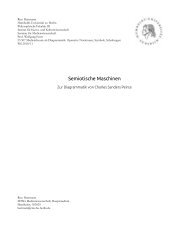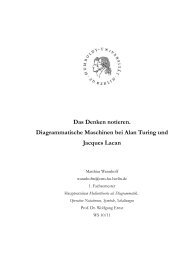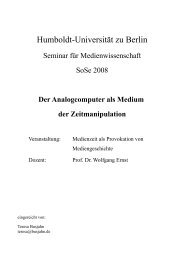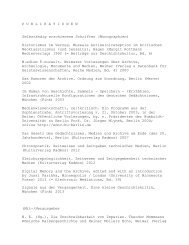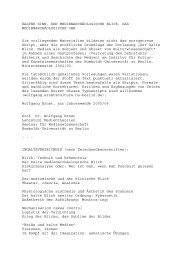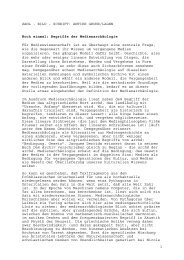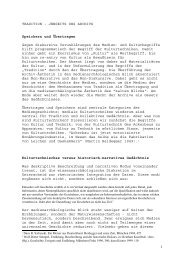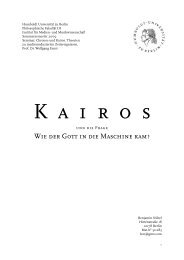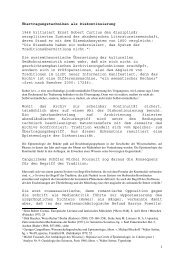Download - Medienwissenschaft
Download - Medienwissenschaft
Download - Medienwissenschaft
You also want an ePaper? Increase the reach of your titles
YUMPU automatically turns print PDFs into web optimized ePapers that Google loves.
y analogy, it does not follow from a geometrically accurate description of original and<br />
copy that the copy is semantically error-free. 86<br />
According to Benjamin, one characteristic of the original is its translatability; there<br />
exists a relational connection (intimate) between original and translation as though the<br />
need for translation were intrinsic to the original: "Translatability is an inherent property<br />
of certain works." 87 And for Benjamin, this relational concept does not refer to an interpretative,<br />
but to a relational-formal connection between translation and original - a relationship<br />
that could therefore also be formalised in the sense of technological transfer (on<br />
the lines of Shannon / Weaver's Mathematical Information Theory 88 ). Whereby video encodes<br />
this real relationship technologically, not symbolically, and the difference between<br />
original and (technological signal) translation / transfer ceases to exist altogether. For<br />
Benjamin, truth is a given - in technology, these givens are data. At any rate, time-based<br />
processes: "legibility, like translatability, occurs only with time". 89 Could one say, analogously,<br />
that video is the memory-based reproduction of a picture whose nature it is to be<br />
recorded?<br />
In principle, the technological function of the video recorder is to store television<br />
signals by converting their frequencies into electromagnetic impulses, writing these onto<br />
a magnetic tape by means of one or more magnetic heads, reading them off for reproduction,<br />
and transmitting them to the receiver, again in the form of frequencies. 90<br />
For television as a live medium in particular, this was not true for a long time, since<br />
it was its nature to give out signals.<br />
The Return of the Aura (Behind the Back of Technology)<br />
Although Walter Benjamin denied that the reproducible medium of photography had the<br />
aura of the original, the photo artist Hiroshi Sugimoto manages in his cycle Portraits revisit<br />
the function of the effigies against the backdrop of the legal fiction of the two bodies<br />
of the King in the English Renaissance, described by Ernst Η Kantorowicz. In Madame<br />
Tussaud's London waxworks, he photographed the figures of the British royal families<br />
in such a way that they are posthumously "charged with reality" rather than frozen<br />
into media of transience. 91 It is precisely at the threshold of the digital that the analogue<br />
arts (painting) and media (photography) find their restitution:<br />
In 1999, the video artist Yorck der Knöfel exhibited his Hommage to Painting at the<br />
Berlin Gallery Wohnmaschine, consisting of six monitors arranged in a semicircle that repeated<br />
over and over, in staggered time, a scene of blown-up and bursting balloons. The<br />
difference to painting thus becomes particularly clear in the hommage: "The digitally manipulated<br />
video image can scarcely be traced back to an unmistakable author" 92 - or perhaps<br />
this is a question of the media-competent, critical view, which tries to discriminate<br />
against authors in the new media as well?<br />
This enhancement of the analogue as a criterion of artistic authenticity surely is not<br />
least due to a shift of the stigma of the "reproduction medium" onto digital image processing.<br />
Furthermore, the appreciation of photography is testimony to the fact that the<br />
old media are not, in Hegel's sense, simply "merging" into the new, but that it is preci-<br />
- 164 -



